The primary focus of my trip to London with Antonia was art galleries. We saw sculpture in Canada House, off Trafalgar Square. We saw paintings in the National Gallery, National Portrait Gallery, and Tate Modern; also, photography in the National Theatre and additional sculpture in other places. Seeing art with a clever and interested fellow observer is wonderful for offsetting the overwhelming character of a place like any of the museums listed above. When that other person is also well versed in historical and mythological iconography, it is even more welcome. When you have dozens of original Dalis, Kandinskys, and Picassos strewn about, it can be hard to maintain focus.
Developing focus in the first place is hard when you need to wake up at 5:45am. As a reward, we were at the British Museum just in time for its opening. Right now, there is a fascinating temporary exhibit on Arabic calligraphy and artwork. Some of the material included is really superb; I especially enjoyed some of the examples where Asiatic kinds of calligraphy and Arabic lettering had been forged into elegant hybrids. Before leaving the British Museum, we also took a guided tour of the Islamic World section, as well as wandering on our own through the North American, Central American (where many of the sculptures have superb facial expression), and ancient British Isles areas. As always, the central atrium – installed sometime before my first visit in 2001 – is a striking piece of artwork in its own right, much like the turbine room in the Tate Modern. I love the elation and sense of safety I feel when enclosed in huge open-air geometric spaces.
After walking through Soho and Chinatown, Antonia and I arrived in Trafalgar Square. After a perfunctory security check, we were allowed into Canada House, though sadly not invited to the wine reception that was being prepared. Instead, I got around to finally registering as a Canadian national living in the UK and we had a look at some of the Canadian stone sculpture that was on display.
I really should dig through all the collected brochures to attach names to these descriptions, but I have neither the time nor the energy just now. Perhaps in future sittings.
Also at Trafalgar Square (aside from a version of Nelson’s column covered with scaffolding for repair, with the scaffolding decorated with sea life as a warning about global warming) are the National Gallery and National Portrait Gallery. At the first, we saw a terrifically frightening dragon that I am hoping Antonia will identify in a comment. All efforts at photography there were quite effectively thwarted. As has generally been the case, the National Portrait Gallery was an illustration of how few British authors, politicians, and public figures I have heard of. They lack a portrait of Douglas Adams: an oversight that really must be rectified.
Between that and the next art viewing (at the National Theatre), we met with two sets of Antonia’s friends – the first a friend from ancient schooldays and the second the kind gentleman who put a roof over my head for the unplanned overnight stay. At the National Theatre, we saw an exhibition of the top photojournalistic images of the year. Some were extremely good – particularly a portrait of Kofi Annan that makes superb use of contrast, composition, and dynamic range. Many were exceptionally gruesome, as I suspect is not unusual for such compositions.
After pizza-walking-sleep-wake-shower, the next day proceeded to the Tate Modern via a picnic. From National Theatre to Antonia’s friend Jong’s house was one long arc with the Gherkin as the central point. The return trip to the Tate Modern was essentially the converse. Since the recent major re-hang, I don’t entirely have my bearings in that fascinating place. As such, every return visit has the feel of rediscovery to it, much as I lament the fact that Hepworth’s Pelagos has been relocated to Cornwall. There, we met another friend of Antonia’s who is on the Tate staff related to planning and executing activities for children and families. A great way to be initiated into such a wonderful collection of art, no doubt.
My thanks to Antonia for the company that was the highlight of the trip, and to Jong who was kind enough to accompany us for a long while, and house us as well.
I would write more, but I need to get to sleep. It’s another 6:00am reveille tomorrow.

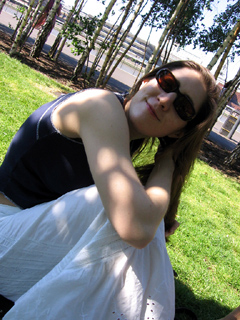
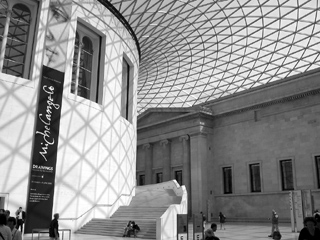
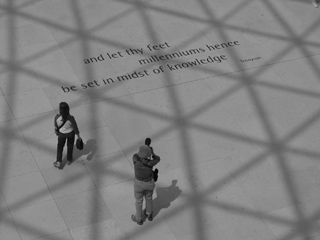
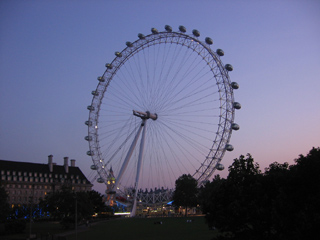
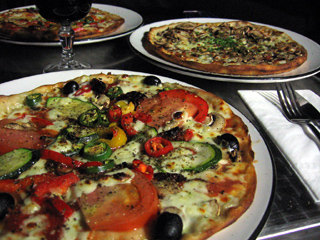
Did you check out the “lobster telephone?”
Kerrie,
Yes. It’s right beside ‘The Metamorphosis of Narcissus” – a painting I rather like.
It seems like you had quite a weekend, I’m glad. I had a decent weekend aswell, which involved many kilometers of biking along the lakeshore, and a wonderful (Christian?) Reggae band called “Rhythm and Truth”.
The photo of the inscription on the ground I find chilling. I’d be intersted in knowing what kind of concrete was used, and if there was any chance that it would still be in good condition a few hundred years hence, let alone thousands. If it were to crumble prematurely, this would be the best, for then its very construction speak the contradiction inherent in the danger the modern technology will continue to lord over the earth for milleniums hence.
That pizza photo is AWESOME.
God damn, I want some pie.
“If it were to crumble prematurely, this would be the best, for then its very construction speak the contradiction inherent in the danger the modern technology will continue to lord over the earth for milleniums hence.”
Tristan,
That photo is from the atrium of the British Museum. If there’s one thing the place is not about, it’s modern technology.
Two Followers of Cadmus devoured by a Dragon (1588) Cornelis van Haarlem (link)
Sorry – I got interrupted halfway through the comment above and stuffed up the link.
Johg is Jong btw
Antonia,
I fixed the spelling and your link. Thanks for pointing them out.
“Skill without imagination is craftsmanship and gives us many useful objects such as wickerwork picnic baskets. Imagination without skill gives us modern art.”
Tom Stoppard